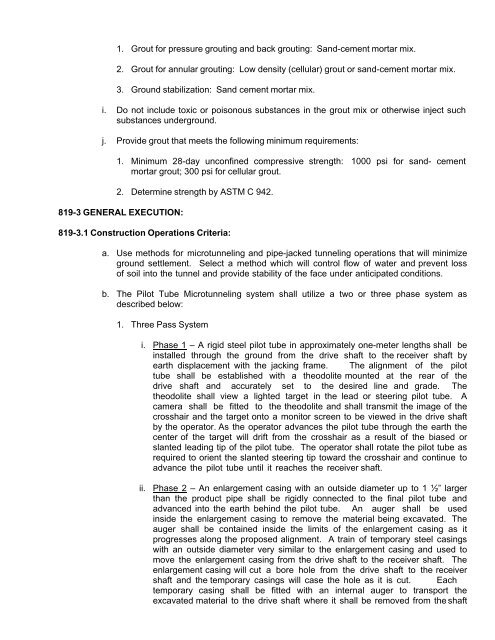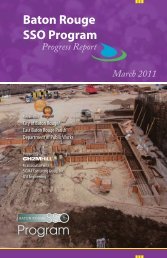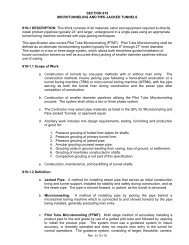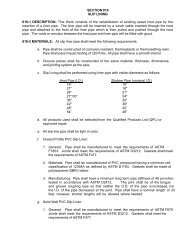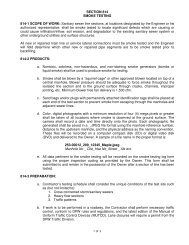SECTION 819 MICROTUNNELING AND PIPE-JACKED TUNNELS ...
SECTION 819 MICROTUNNELING AND PIPE-JACKED TUNNELS ...
SECTION 819 MICROTUNNELING AND PIPE-JACKED TUNNELS ...
- No tags were found...
Create successful ePaper yourself
Turn your PDF publications into a flip-book with our unique Google optimized e-Paper software.
1. Grout for pressure grouting and back grouting: Sand-cement mortar mix.<br />
2. Grout for annular grouting: Low density (cellular) grout or sand-cement mortar mix.<br />
3. Ground stabilization: Sand cement mortar mix.<br />
i. Do not include toxic or poisonous substances in the grout mix or otherwise inject such<br />
substances underground.<br />
j. Provide grout that meets the following minimum requirements:<br />
1. Minimum 28-day unconfined compressive strength: 1000 psi for sand- cement<br />
mortar grout; 300 psi for cellular grout.<br />
2. Determine strength by ASTM C 942.<br />
<strong>819</strong>-3 GENERAL EXECUTION:<br />
<strong>819</strong>-3.1 Construction Operations Criteria:<br />
a. Use methods for microtunneling and pipe-jacked tunneling operations that will minimize<br />
ground settlement. Select a method which will control flow of water and prevent loss<br />
of soil into the tunnel and provide stability of the face under anticipated conditions.<br />
b. The Pilot Tube Microtunneling system shall utilize a two or three phase system as<br />
described below:<br />
1. Three Pass System<br />
i. Phase 1 – A rigid steel pilot tube in approximately one-meter lengths shall be<br />
installed through the ground from the drive shaft to the receiver shaft by<br />
earth displacement with the jacking frame. The alignment of the pilot<br />
tube shall be established with a theodolite mounted at the rear of the<br />
drive shaft and accurately set to the desired line and grade. The<br />
theodolite shall view a lighted target in the lead or steering pilot tube. A<br />
camera shall be fitted to the theodolite and shall transmit the image of the<br />
crosshair and the target onto a monitor screen to be viewed in the drive shaft<br />
by the operator. As the operator advances the pilot tube through the earth the<br />
center of the target will drift from the crosshair as a result of the biased or<br />
slanted leading tip of the pilot tube. The operator shall rotate the pilot tube as<br />
required to orient the slanted steering tip toward the crosshair and continue to<br />
advance the pilot tube until it reaches the receiver shaft.<br />
ii. Phase 2 – An enlargement casing with an outside diameter up to 1 ½” larger<br />
than the product pipe shall be rigidly connected to the final pilot tube and<br />
advanced into the earth behind the pilot tube. An auger shall be used<br />
inside the enlargement casing to remove the material being excavated. The<br />
auger shall be contained inside the limits of the enlargement casing as it<br />
progresses along the proposed alignment. A train of temporary steel casings<br />
with an outside diameter very similar to the enlargement casing and used to<br />
move the enlargement casing from the drive shaft to the receiver shaft. The<br />
enlargement casing will cut a bore hole from the drive shaft to the receiver<br />
shaft and the temporary casings will case the hole as it is cut. Each<br />
temporary casing shall be fitted with an internal auger to transport the<br />
excavated material to the drive shaft where it shall be removed from the shaft


